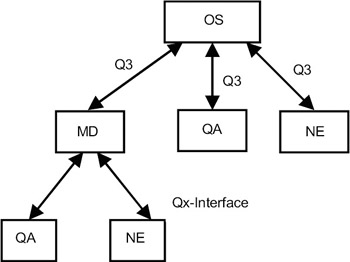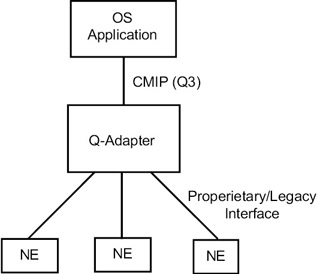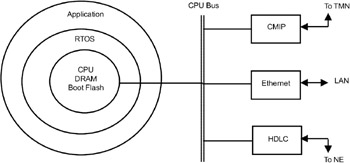37.3 TMN STANDARD INTERFACES
|
| < Day Day Up > |
|
37.3 TMN STANDARD INTERFACES
Three standard interfaces are defined in TMN: Q, F, and X interfaces.
Q-interface: The Q-interfaces are shown in Figure 37.5. Q-interface is defined between two TMN-compliant functional blocks. Q3 interface is defined between NE and OS, QA and OS, MD and OS, and OS and OS. Qx interface is defined between MD and QA, MD and NE.

Figure 37.5: TMN Q-interface.
F-interface: The F-interface is defined between WS and OS, WS and MD.
X-interface: X-interface is defined between two TMN-compliant OSs in two separate TMN domains. This interface is for two TMNs to exchange management information.
The heart of TMN is the Q-interface or the Q-adapter. As shown in Figure 37.6, a legacy network element that is presently running, such as SNMP for network management, can be brought into the purview of TMN through the Q-interface. The NE can run the SNMP software and through the Q-adapter, the OS can manage the NE. Between the OS and the Q-adapter, the CMIP/Q3 protocol is running and the Q-adapter interfaces between the legacy NE and the TMN-compliant OS.

Figure 37.6: TMN Q-adapter.
The three standard interfaces defined in TMN are Q-interface, F-interface, and X-interface. The heart of TMN is Q-interface or Q-adapter.
The architecture of a Q-agent is shown in Figure 37.7. The Q-agent runs a real-time operating system above which the application is running. The Q-agent is connected to the TMN through CMIP and to the NE through a data communication link that can run, for instance, HDLC protocol. It also can be connected to the LAN through a normal Ethernet interface. Note that the Q-agent is basically an embedded system running a real-time operating system.

Figure 37.7: Q-agent architecture.
The complete TMN architecture and the building blocks and protocols are shown in Figure 37.8. A network element (such as a switch, multiplexer, or repeater) will be running the Q-agent software. The Operations System manages these network elements through the Q3 protocol. The OS is connected to the operation, administration, and maintenance (OAM) center through the work station. The TMN consists of a number of OSs networked together to get a global view of the whole telecommunication network and to manage it effectively.

Figure 37.8: Typical TMN architecture.
A network element such as a switch, multiplexer, or repeater will be running the Q-agent software. The operations system manages the network element using Q3 protocol.
Though many of the network elements presently do not have TMN compliance, all telecom equipment suppliers are now integrating TMN protocols in the network elements. The telecom service providers also are insisting on TMN interface for equipment because it will make network management extremely easy. TMN provides the capability to manage complex telecommunication networks of the future.
| Note | Many of the present network elements do not have TMN compliance. However, using a Q-adapter, these network elements still can be managed by the TMN. |
Summary
As the complexity of telecommunications networks increases managing the networks has become an important issue. A telecommunications management network (TMN) is a network based on standard protocols for efficient management of telecommunications networks. Even legacy network elements such as switches, and routers can be managed through the TMN using appropriate interfaces. In this chapter, the architecture of TMN is presented. In the TMN framework, a special protocol named common management information protocol (CMIP) is defined through which management services are exchanged. The TMN is a data communication network (DCN) that carries the management information through operations systems (OSs) that monitor different network elements (NEs). The NEs will have standard TMN interfaces to be controlled by OSs. If NEs do not have TMN interfaces, they can be managed by Q-adapters. Q-adapters are required for old (legacy) NEs. TMN will also have work stations (WSs) to provide the user interface for monitoring and control.
TMN provides an excellent mechanism for controlling the different telecommunications equipment, and all telecommunications service providers are deploying the TMN.
References
-
http://www.iec.org/online/tutorials/tmn This link gives a tutorial on TMN.
-
http://www.simpleweb.org/tutorials/tmn This link also gives a good overview of TMN.
-
http://www.itu.int The official Web site of International Telecommunications Union. An excellent repository of ITU standards.
Questions
-
Explain the architecture of a telecommunications management network.
-
What are the building blocks of TMN? Explain the functionality of each block.
-
What are the standard TMN interfaces?
-
Explain how a network element that does not have a standard TMN interface can be managed through the TMN.
Exercises
| 1. | Study the various TMN products offered by vendors such as Cisco, Nortel, Ericsson, and Lucent Technologies. | |
| 2. | Study the details of Q-interface and explore how non–TMN-compliant network elements can be brought under the purview of TMN. | |
Answers
| 1. | You can get the details of TMN products from the following sites: http://www.cisco.com, http://www.nortelnetworks.com, http://www.ericsson.com, http://www.lucent.com, and http://www.sun.com. |
| 2. | You can obtain the details from http://www.netmansys.fr and http://www.eurescom.de. |
Projects
-
Simulate a TMN on a local area network. Each node on the LAN can be considered a network element of the TMN. The LAN cable provides the connectivity between the network elements. Simulate the CMIP protocol.
-
Implement Q-agent architecture on an embedded system. You can use ARM/ Motorola/Intel processor-based hardware, port a real-time operating system such as QNX or RTLinux, and then implement the software as shown in Figure 37.7.
|
| < Day Day Up > |
|
EAN: 2147483647
Pages: 313